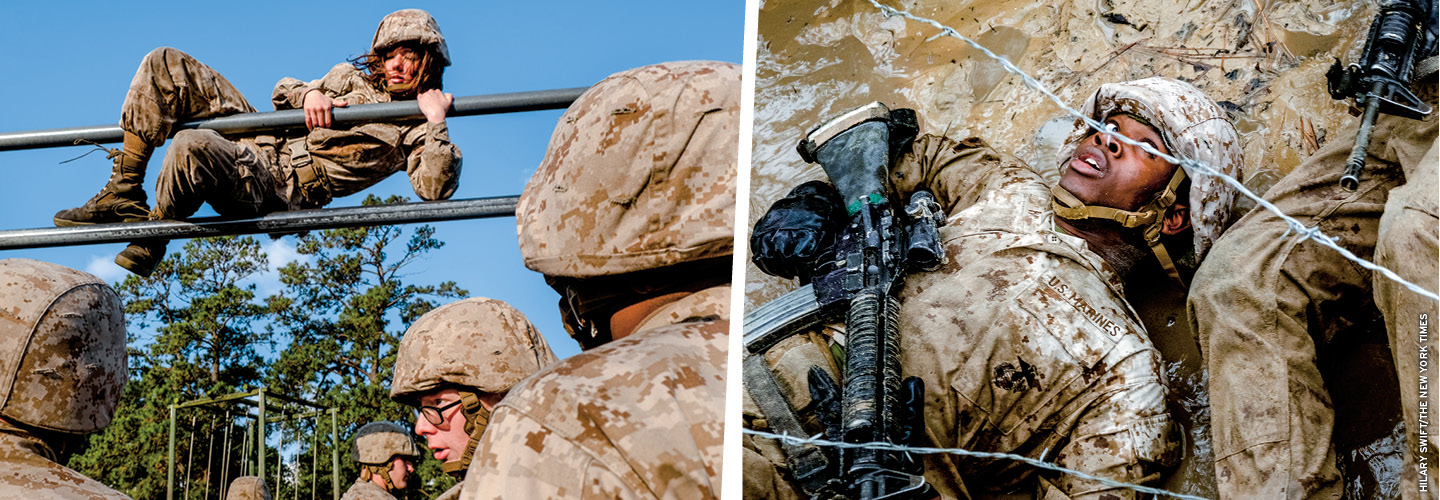Jacob James, a 19-year-old recruit, eyed the rope bridge in front of him at Parris Island, a Marine Corps training base in the South Carolina marsh. It was the first day of the Crucible, the final, 54-hour field exercise that signifies the transition from recruit to Marine. For this obstacle, James was in charge of 15 of his peers, both men and women. Their goal: Move half a dozen 30-pound ammunition cans across the bridge.
It was the first time the roughly 330 men and women in Bravo Company were forced to work and speak with one another with a shared aim of completing a goal. About 11 weeks of training had already passed.
The male and female recruits had participated in other exercises, sometimes feet apart, practicing martial arts or on separate firing lines at the rifle range. But they had rarely spoken to each other. Individual platoons at Marine Corps boot camp remain separated by gender.
Now for the Crucible, the recruits of Bravo Company were no longer in their platoons but were instead smashed into smaller units of both genders from the company.
James laid out his plan to move the ammo cans: They would take a strand of cord connected to the cans, hang it over their necks and shuffle across the rope bridge.
Katelin Bradley, 19, standing in the huddled mass of her peers, raised her eyebrows. This did not sound like a good idea. She suggested attaching the cord connected to the cans to the rope bridge itself and pushing the load to the other side.
James pondered the idea and dismissed it. “The men are strong enough and can do it,” he said.
Bradley fell back into formation, taking her post on the edge of the obstacle, providing security from any possible, albeit fake, enemies.
Jacob James eyed the rope bridge in front of him at Parris Island, a Marine Corps training base in the South Carolina marsh. The 19-year-old recruit was participating in the first day of the Crucible. This final, 54-hour field exercise marked the transition from recruit to Marine. For this obstacle, James was in charge of 15 of his peers, both men and women. Their goal: Move half a dozen 30-pound ammunition cans across the bridge.
There were roughly 330 men and women in Bravo Company. It was the first time they had to work and speak with one another to complete a goal. About 11 weeks of training had already passed.
The male and female recruits had participated in other exercises. Sometimes they were only feet apart, practicing martial arts or on separate firing lines at the rifle range. But they had rarely spoken to each other. Individual platoons at Marine Corps boot camp remain separated by gender.
Now, for the Crucible, the recruits of Bravo Company were no longer in their platoons. Instead, they were put into smaller units of both genders from the company.
James laid out his plan to move the ammo cans: They would take a strand of cord connected to the cans, hang it over their necks and shuffle across the rope bridge.
Katelin Bradley, 19, standing in a huddle of her peers, raised her eyebrows. This did not sound like a good idea. She suggested attaching the cord connected to the cans to the rope bridge itself and pushing the load to the other side.
James thought about the idea and dismissed it. “The men are strong enough and can do it,” he said.
Bradley fell back into formation. She took her post on the edge of the obstacle. She was set to provide security from any possible, albeit fake, enemies.

